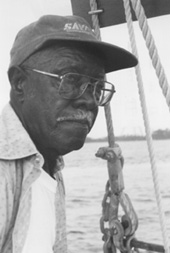
Chesapeake Outdoors
Earl White, Admiral of the Chesapeake
by C.D. Dollar
If we are fortunate, once in a great while into
our lives comes a person who transcends generational, gender, racial and
social boundaries as effortlessly as an eagle soars in the air currents.
Earl White is such a man, a legend on the Chesapeake Bay who symbolizes
the rich cultural fabric that is life in Bay country.
Born in Dames Quarter, Md., 80 years ago, Earl has followed the water since he was 19, mostly sailing aboard skipjacks, symbols of a bygone era that speak to the Bay’s once unequaled vitality. When Earl turned 80 this week, there was an explosion of celebrations. Much of the credit for the accolades goes to Vincent Leggett, director of the Blacks on the Chesapeake project, who has compiled an energetic and inspiring multimedia presentation of the experience of African-American watermen.
Earl White Day in Annapolis was celebrated with a birthday party with family and friends aboard the Chesapeake Bay Foundation skipjack, Stanley Norman, where Earl has worked for the last 10 years. True to his character, Earl led a field trip for middle schoolers on his birthday.
That same evening, family, friends and politicians (they know a good thing when they see it) came to Annapolis to celebrate with Earl. To honor his distinguished career, Maryland Gov. Parris Glendening presented Earl with one of the state’s highest honors, naming him an Admiral of the Chesapeake.
To put Earl’s life on the water in some perspective, consider this: as the storm clouds gathered over Europe and America emerged from financial ruin, Earl was working the water, dredging for oysters. When Hurricane Hazel pummeled the Atlantic coast in ’54, Earl was delivering a load of oysters. When the nation faced internal strife and political upheaval in the 1960s and ’70s, Earl was sailing skipjacks, earning a hard living from Chesapeake waters. And today, Earl still works those waters.
Ask any watermen, and they’ll tell you the hardest job on the water is "drudgin’ for artsers," and Earl has done it in parts of seven decades.
When the oyster industry crashed from over-harvesting, pollution and disease, Earl took his vast knowledge of the Bay and oysters to the Chesapeake Bay Foundation as a field educator aboard the Stanley Norman. Through his unique perspective, he teaches people about oyster reefs as incredible filters, habitats and food for marine plants and animals, as well as their one-time value as a commercial fishery.
Those who have had the privilege to work with Earl know him as a patient, genuine, honest and straightforward man. He often connects with students when others have difficulty. Earl easily shares his love of the Chesapeake with everyone he meets. He is living maritime history. And his stories relating days of abundant oyster harvests, bone-chilling winters on the water and violent squalls enthrall audiences of all ages.
From these accounts, his listeners have gained intimate knowledge of what life was like as a Chesapeake oysterman.
I am in awe not only of Earl’s strength of spirit but also of his physical strength. A few years ago, Earl and I were working a teachers’ trip on the Patuxent River. He had mesmerized the teachers with stories of abundant oyster hauls decades earlier on the Hawks Nest, an old, worn-out oyster bar upriver from Solomons.
I brought along a set of 14-foot shaft tongs to demonstrate to the group another method used to harvest oysters. With the boat anchored over the bar, I lowered the tongs into the swift ebb tide and struggled to get a bite on the shell. Then I began to pull the tongs up — I am not a weak man — but getting them aboard was tough.
Without a hint of trying to show me up, Earl took his turn, and like a knife through butter, cut the water, spread the tongs then pulled them up in a motion as fluid and graceful as a choreographed ballet. I will never forget that sight: a man nearly half a century older than I working the shaft tongs like they were chopsticks.
The formal acknowledgments of Earl’s great contributions to the Bay solidify what those who know and love Earl have recognized all along: that he has enriched the lives of everyone he has touched. Earl has inspired us all with his love of life and generosity of spirit. Thanks, Earl.